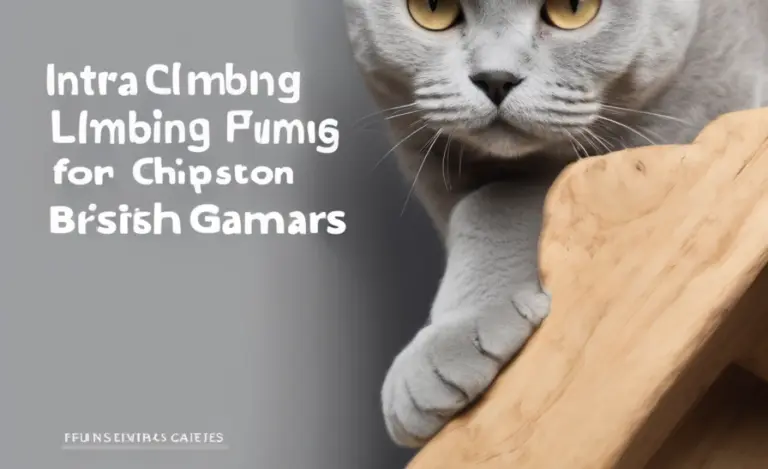Bathing Schedule for British Shorthair Kittens: Ultimate Guide
The ideal bathing schedule for British Shorthair kittens is infrequent. Generally, bathe them only when visibly dirty or smelly, which might be every few months. Over-bathing can strip their coat of essential oils, leading to skin irritation. Use a kitten-safe shampoo and make the experience gentle and positive to avoid stressing your new furry friend.
Bringing a British Shorthair kitten into your home is a joyous occasion! Their plush coats and sweet personalities make them wonderful companions. One question many new owners have is about bathing: How often should you bathe your British Shorthair kitten? It’s a valid concern, as over-bathing can do more harm than good. Don’t worry; we’ll walk through a simple, stress-free bathing schedule to keep your kitten clean and happy.
In this guide, you’ll learn when and how to bathe your British Shorthair kitten, what supplies you’ll need, and how to make bath time a positive experience. We’ll also cover common mistakes to avoid and answer frequently asked questions. Let’s get started!
Why Bathing Frequency Matters for British Shorthair Kittens
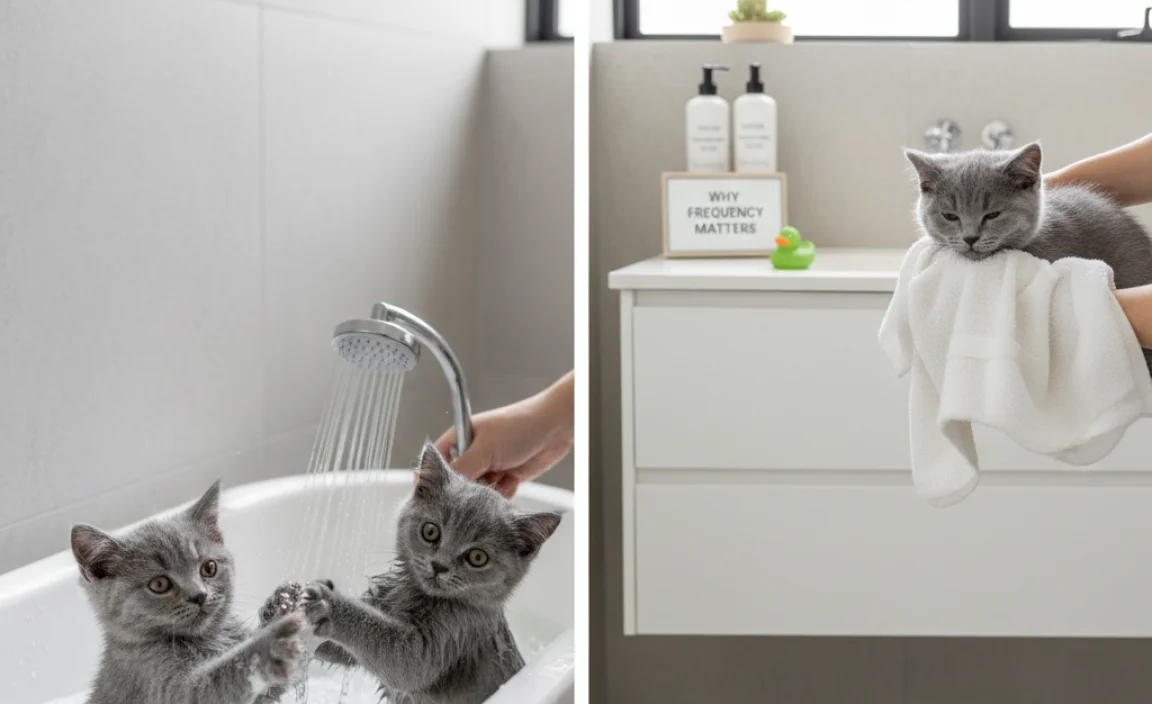
British Shorthairs have dense, plush coats that are naturally water-repellent and easy to maintain. Regular bathing isn’t necessary and can actually be detrimental to their skin and coat health. Understanding why infrequent bathing is better will help you create a healthy grooming routine for your kitten.
Natural Oils and Skin Health
Cats produce natural oils that keep their skin moisturized and their coats shiny. These oils also provide a protective barrier against environmental irritants. Over-bathing strips these essential oils away, leading to:
- Dry skin and dandruff
- Increased risk of skin infections
- A dull, brittle coat
According to the RSPCA, frequent bathing can disrupt the natural balance of a cat’s skin, making it more susceptible to problems.
Self-Grooming Habits
Cats are meticulous groomers. British Shorthairs spend a significant portion of their day cleaning themselves. Their barbed tongues act like natural combs, removing dirt and loose hair. Unless your kitten gets into something particularly messy, their self-grooming is usually sufficient to keep them clean.
Stress and Anxiety
Most cats don’t enjoy being bathed. It can be a stressful experience, especially for kittens. Forcing a bath can create anxiety and damage the bond between you and your pet. Minimizing baths reduces the risk of associating you with negative experiences.
Creating a Bathing Schedule
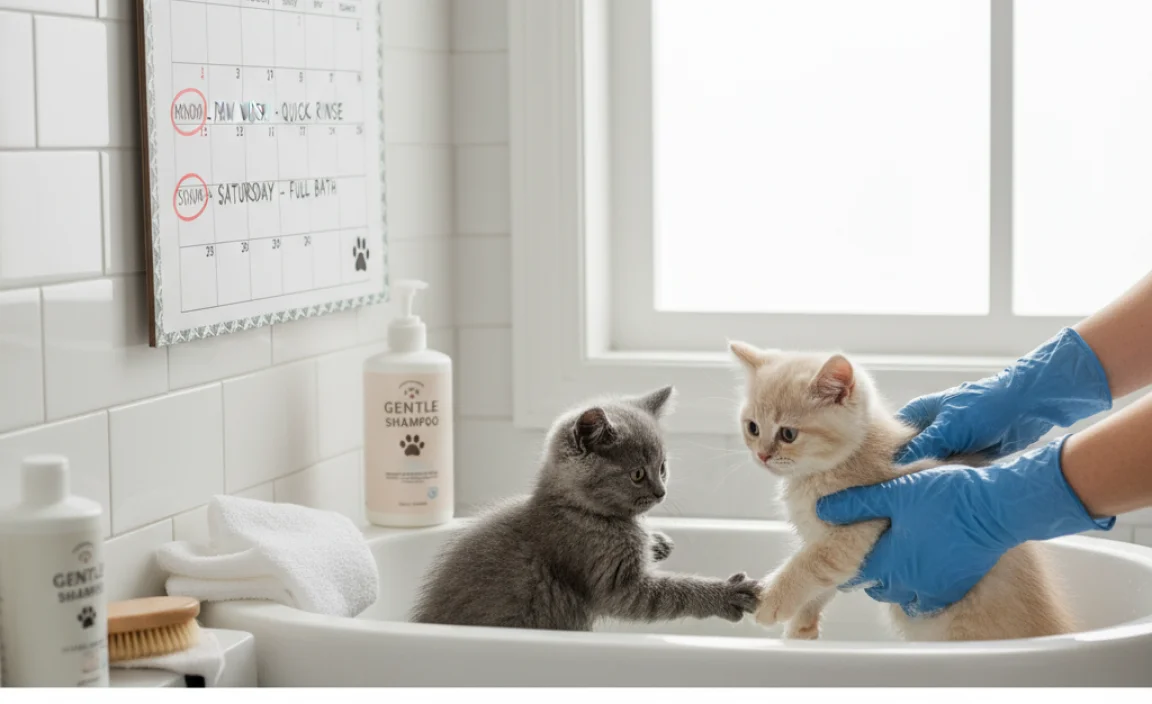
Now that you understand the importance of infrequent bathing, let’s create a practical schedule for your British Shorthair kitten.
Assessing the Need for a Bath
Before reaching for the shampoo, ask yourself if a bath is truly necessary. Here are some signs that your kitten might need a bath:
- Visible dirt or grime on their coat
- A persistent odor that self-grooming hasn’t eliminated
- Exposure to something sticky or toxic
If none of these apply, a simple spot clean might be all your kitten needs.
Recommended Bathing Frequency
As a general rule, aim to bathe your British Shorthair kitten no more than once every few months. Some kittens may never need a full bath, while others might require it more often due to their lifestyle or environment. Always prioritize their skin and coat health over a rigid schedule.
Adjusting for Specific Situations
Certain situations might warrant more frequent bathing:
- Skin Conditions: If your vet prescribes medicated baths for a skin condition, follow their specific instructions.
- Allergies: If someone in your household has cat allergies, more frequent bathing (as recommended by a vet) might help reduce allergens.
- Show Cats: If you plan to show your British Shorthair, you’ll likely need to bathe them more often to maintain a pristine appearance. Consult with experienced breeders for guidance.
Step-by-Step Guide to Bathing Your British Shorthair Kitten
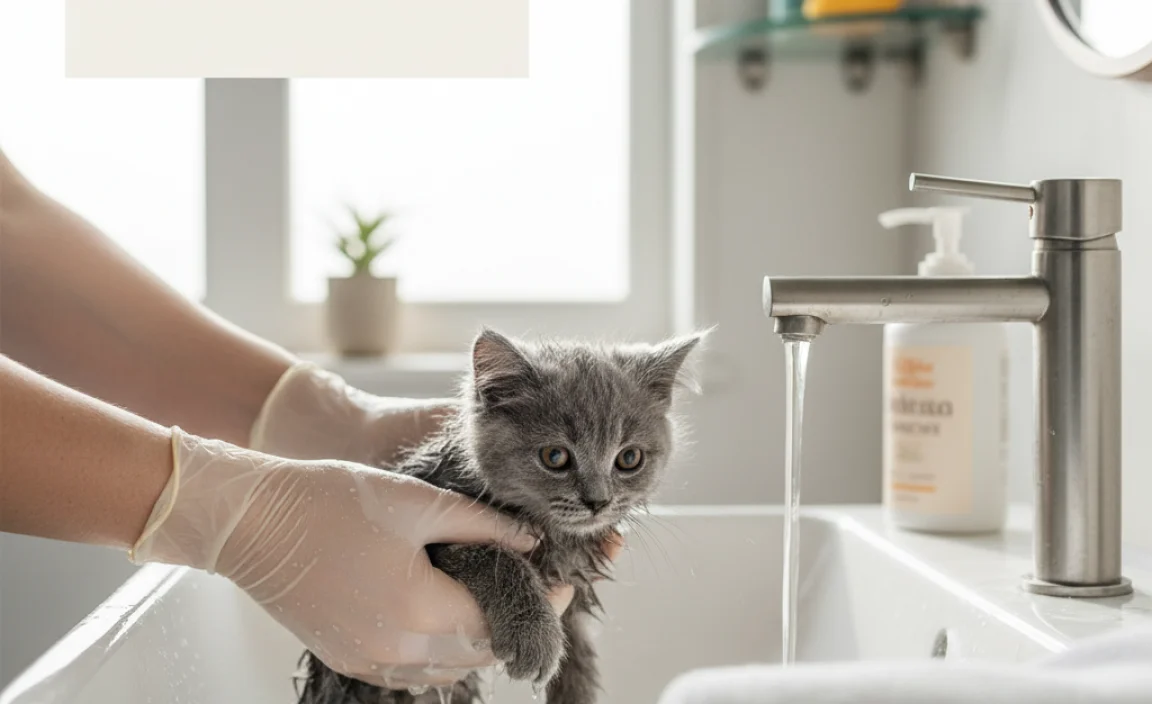
When a bath is necessary, follow these steps to make the experience as stress-free as possible for both you and your kitten.
1. Gather Your Supplies
Before you even think about turning on the water, gather everything you’ll need. This will minimize stress and ensure a smooth process. Here’s a checklist:
- Kitten-safe shampoo: Look for a gentle, tear-free formula specifically designed for kittens.
- Non-slip mat: Place this in the sink or tub to provide secure footing.
- Soft towels: Have several on hand for drying.
- Pitcher or cup: For rinsing.
- Grooming brush: To remove mats and tangles beforehand.
- Treats: To reward good behavior.
2. Prepare the Bathing Area
Choose a quiet, warm room to minimize distractions and keep your kitten comfortable. The bathroom sink or a small tub works well. Here’s how to prepare the area:
- Close the door: This prevents escape attempts.
- Place the non-slip mat: In the sink or tub.
- Fill with lukewarm water: The water should be comfortably warm, not hot or cold. Test it with your wrist.
- Have everything within reach: Shampoo, towels, and rinse water should be easily accessible.
3. Brush Your Kitten
Before getting your kitten wet, gently brush their coat to remove any mats, tangles, or loose hair. This makes the bathing process easier and more effective. Use a soft-bristled brush or a grooming glove.
4. Introduce Your Kitten to the Water
Slowly introduce your kitten to the water. Use a calm, soothing voice and offer reassurance. Gently pour water over their body, avoiding the head and face. Use a pitcher or cup for better control.
5. Apply Shampoo
Once your kitten is wet, apply a small amount of kitten-safe shampoo. Gently massage it into their coat, working from head to tail. Avoid getting shampoo in their eyes, ears, and mouth. Focus on areas that are particularly dirty or smelly.
6. Rinse Thoroughly
Rinsing is crucial to remove all traces of shampoo. Use the pitcher or cup to pour clean, lukewarm water over your kitten’s body until the water runs clear. Shampoo residue can cause skin irritation, so take your time and be thorough.
7. Dry Your Kitten
Once rinsed, wrap your kitten in a soft towel and gently pat them dry. Avoid rubbing vigorously, as this can cause matting. Use multiple towels as needed. If your kitten tolerates it, you can use a low-heat hair dryer on the lowest setting, keeping it moving and a safe distance from their skin.
8. Reward and Praise
After the bath, offer plenty of praise and treats. This helps create a positive association with bath time. Play with your kitten and offer extra attention to reinforce good behavior.
Dealing with Difficult Kittens

Not all kittens enjoy bath time. Some may resist or become anxious. Here are some tips for dealing with difficult kittens:
- Start young: Introduce your kitten to water and bathing early in life. Even if you don’t bathe them, get them used to being handled and exposed to water.
- Stay calm: Your kitten can sense your stress. Stay calm and speak in a soothing voice.
- Use treats: Offer treats throughout the bath to reward good behavior.
- Keep it short: The shorter the bath, the better. Focus on cleaning the essential areas and don’t prolong the process.
- Enlist help: If possible, have someone assist you. One person can hold and reassure the kitten while the other washes and rinses.
- Consider spot cleaning: If your kitten is extremely resistant, opt for spot cleaning with a damp cloth instead of a full bath.
Spot Cleaning Techniques
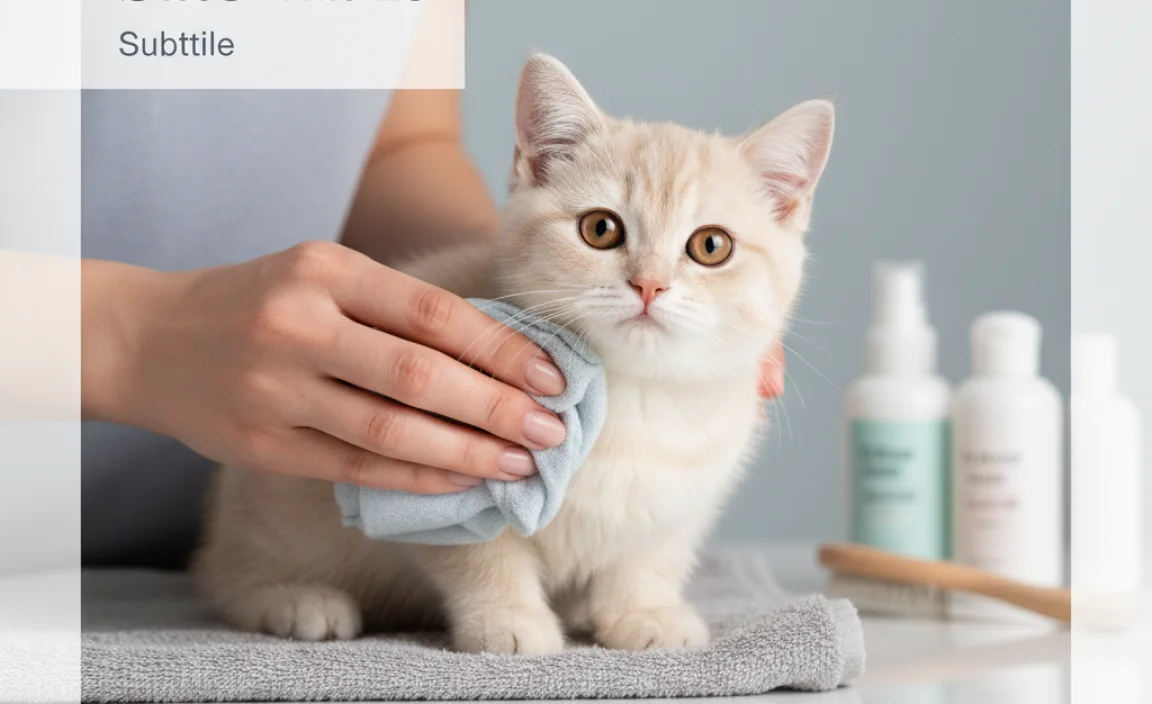
Sometimes, a full bath isn’t necessary. Spot cleaning can be a great alternative for minor messes or odors. Here are some effective techniques:
- Damp cloth: Use a soft, damp cloth to gently wipe away dirt or grime. Focus on the affected area and avoid soaking the fur.
- Pet wipes: Unscented pet wipes are convenient for quick cleanups. Make sure they are alcohol-free and safe for kittens.
- Dry shampoo: Dry shampoo is a powder that absorbs oil and dirt. Sprinkle it on your kitten’s coat, massage it in, and then brush it out.
- Cornstarch: In a pinch, cornstarch can be used as a dry shampoo. Apply it to the affected area, let it sit for a few minutes, and then brush it out.
Choosing the Right Products
Selecting the right grooming products is essential for maintaining your British Shorthair kitten’s skin and coat health. Here are some guidelines:
Shampoo
- Kitten-safe: Always use a shampoo specifically formulated for kittens. These are gentler and less likely to cause irritation.
- Tear-free: Look for a tear-free formula to protect your kitten’s eyes.
- Hypoallergenic: If your kitten has sensitive skin, choose a hypoallergenic shampoo.
- Avoid harsh chemicals: Avoid shampoos with sulfates, parabens, and artificial fragrances.
Conditioner
While not always necessary, a kitten-safe conditioner can help keep your British Shorthair’s coat soft and manageable. Use it sparingly and rinse thoroughly.
Brushes
- Soft-bristled brush: This is ideal for everyday grooming and removing loose hair.
- Slicker brush: A slicker brush can help remove mats and tangles, but use it gently to avoid irritating the skin.
- Grooming glove: A grooming glove is a gentle way to remove loose hair while petting your kitten.
Common Mistakes to Avoid
To ensure a safe and positive bathing experience, avoid these common mistakes:
- Using human shampoo: Human shampoo is too harsh for kittens and can strip their skin of essential oils.
- Getting water in the ears: Water in the ears can lead to infections. Use cotton balls to gently clean the outer ears, but avoid inserting anything into the ear canal.
- Using hot or cold water: Lukewarm water is the safest and most comfortable temperature for kittens.
- Leaving shampoo residue: Thorough rinsing is essential to prevent skin irritation.
- Forcing a bath: If your kitten is extremely resistant, don’t force it. Try again another time or opt for spot cleaning.
- Ignoring signs of stress: Watch for signs of stress, such as hissing, swatting, or trying to escape. If your kitten is too stressed, stop the bath and try again later.
Maintaining a Healthy Coat Between Baths
Regular grooming is key to keeping your British Shorthair kitten’s coat healthy and beautiful between baths. Here are some tips:
- Brush regularly: Brush your kitten several times a week to remove loose hair and prevent mats.
- Provide a good diet: A balanced diet rich in omega-3 and omega-6 fatty acids promotes healthy skin and a shiny coat.
- Keep them indoors: Indoor cats are less likely to get dirty or exposed to environmental irritants.
- Regular vet checkups: Regular vet visits can help identify and address any underlying skin or coat issues.
Table: Bathing Supplies Checklist
| Item | Description | Why You Need It |
|---|---|---|
| Kitten-Safe Shampoo | Gentle, tear-free formula | Cleans without irritating skin |
| Non-Slip Mat | Rubber or silicone mat | Provides secure footing |
| Soft Towels | Multiple, absorbent towels | Dries kitten quickly and comfortably |
| Pitcher or Cup | For rinsing | Allows controlled water flow |
| Grooming Brush | Soft-bristled brush | Removes mats and loose hair |
| Treats | Small, tasty rewards | Positive reinforcement |
Table: Bathing Frequency Guide
| Situation | Recommended Frequency | Notes |
|---|---|---|
| Normal, healthy kitten | Every few months or as needed | Bathe only when visibly dirty or smelly |
| Skin condition (as directed by vet) | As prescribed by veterinarian | Follow vet’s specific instructions |
| Allergies in household | As recommended by allergist or vet | More frequent bathing may help reduce allergens |
| Show cat | As needed for competitions | Consult with experienced breeders |
FAQs
How often should I bathe my British Shorthair kitten?
Generally, you should bathe your British Shorthair kitten only when necessary, such as when they are visibly dirty or have an unpleasant odor. Over-bathing can strip their coat of essential oils.
What kind of shampoo should I use?
Always use a shampoo specifically formulated for kittens. Look for a gentle, tear-free, and hypoallergenic formula. Avoid shampoos with harsh chemicals like sulfates and parabens.
How can I make bath time less stressful for my kitten?
Prepare everything in advance, use lukewarm water, and speak in a calm, soothing voice. Introduce your kitten to the water slowly and offer treats as positive reinforcement.
Is it okay to use a hair dryer on my kitten?
If your kitten tolerates it, you can use a hair dryer on the lowest heat setting. Keep the dryer moving and a safe distance from their skin to avoid burns. Some kittens prefer to air dry.
What if my kitten hates being bathed?
If your kitten is extremely resistant, don’t force it. Try spot cleaning with a damp cloth or pet wipes. You can also try again another time when they are more relaxed.
Can I use dry shampoo on my British Shorthair kitten?
Yes, dry shampoo can be a good alternative for quick cleanups. Choose a kitten-safe dry shampoo and follow the instructions on the label. Be sure to brush it out thoroughly.
What should I do if my kitten gets shampoo in their eyes?
If your kitten gets shampoo in their eyes, rinse them immediately with plenty of clean, lukewarm water. If irritation persists, consult your veterinarian.
Conclusion
Bathing your British Shorthair kitten doesn’t have to be a daunting task. By understanding their coat and skin needs, creating a gentle bathing routine, and using the right products, you can keep your furry friend clean and happy. Remember, infrequent bathing is usually best, and spot cleaning can often suffice for minor messes. With patience and a little preparation, bath time can become a positive bonding experience for you and your British Shorthair kitten. Enjoy the journey of caring for your beautiful, plush companion!



